Penny Squares and Picture Quilts
Over the past few years, I've seen the phrase, penny squares, in recent publications referring to stamped, commercially sold quilt blocks ready to embroider and suggesting these were popular in the late 19th and early 20th centuries.
However, I've never found advertisements in my vast collection that mention or advertise stamped quilt blocks being sold for only a penny apiece. Quite the contrary. The ads I've found sold these blocks for substantially more. The three earliest commercial examples in my collection are illustrated here.
New England Homestead
(Phelps Publishing, Springfield, MA), April 11, 1908, but the source of the actual blocks and patterns is unknown.O 61---Three More Quilt Blocks
Here are three pretty designs quite different from anything our little girls have had to work into their quilts. These can be worked in the same simple outline stitch which they have used in the earlier designs. The price of the perforated pattern containing the three designs here shown, each of a size for one quilt block, is only 10 cents. If you would rather have them stamped, we offer three blocks stamped on Pequot sheeting, with cotton to work, for only 20 cents. Order from our Fancywork department, this office.
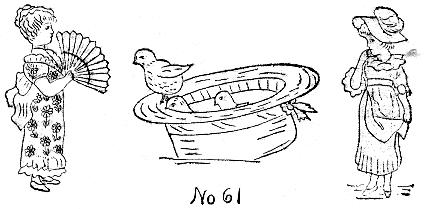
~ ~ ~ ~ ~ ~ ~ ~ ~ ~ ~ ~ ~ ~ ~ ~ ~ ~ ~ ~ ~ ~ ~ ~ ~ ~ ~ ~ ~ ~ ~ ~ ~ ~ ~ ~ ~ ~ ~ ~ ~ ~ ~ ~ ~ ~ ~ ~
Farm and Home (Phelps Publishing, Springfield, MA), October 1, 1909, but the source of the actual blocks and patterns is unknown.
A "Jungle Quilt" for Children's Beds.
Every child delights in animal pictures, and it follows that every child will be delighted with the Farm and Home "Jungle Quilt." As shown by the accompanying illustration, the quilt consists of nineteen pieces. These are to be worked in plain outline stitch, which even little girls can accomplish. The pieces are then to be nicely pressed with a warm iron and neatly sewed together, with or without strips of cloth between each picture, according to the size the quilt is wanted. Finish with a plain border. A good way to make a quilt is to cover layer cotton on both sides with cheesecloth or mosquito netting, tufting here and there, and then to put on the outside covering. In this way the latter can be easily removed when it becomes necessary to wash it, while the cotton in the cheesecloth or netting will only need a good airing in wind and sun. The reverse side of this Jungle Quilt can be lined with silkolene, in color to harmonize or match. The nineteen designs are stamped on separate pieces of chambray of good quality and fast color, and fast-colored cotton is furnished to outline them. The center design is 10x20 inches, and the other eighteen are each 10x10 inches. The designs can be had stamped on either tan or blue chambray, with red cotton to work the former, and white cotton for the latter. The price for the complete quilt, No 743+, including cotton to work, mailed, is $1.35. Or, the quilt may be bought in five installments, the first row, from left to right, being numbered 736+, the second 737+, third 738+, fourth 739+, and fifth and last 740+. The price for each one of these installments, with cotton to work, is 30 cents. It is important that correct numbers be given with orders to avoid misunderstandings. If the complete quilt is wanted at once, order by No 743+. Orders will be filled promptly and satisfactorily. Address Farm and Home Fancywork Department.
The engraving is preceded by a poem, "In the Wilds of Africa," that refers to Colonel Roosevelt (future president Teddy Roosevelt who inspired the teddy bear) and identifies all the animals represented in the quilt blocks.
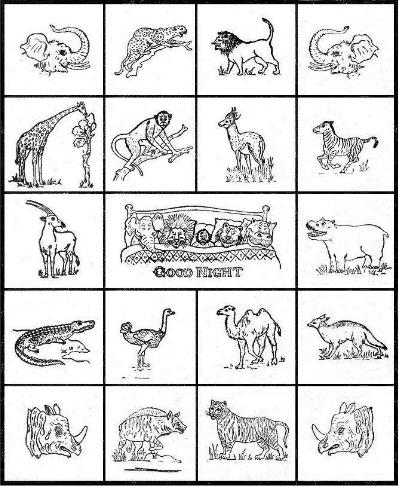
~ ~ ~ ~ ~ ~ ~ ~ ~ ~ ~ ~ ~ ~ ~ ~ ~ ~ ~ ~ ~ ~ ~ ~ ~ ~ ~ ~ ~ ~ ~ ~ ~ ~ ~ ~ ~ ~ ~ ~ ~ ~ ~ ~ ~ ~ ~ ~
Popular Fashions and Woman's Home Journal (Phelps Publishing, Springfield, MA), November 1909, but the source of the actual blocks and patterns is unknown.
Mother Goose Quilt Blocks
We picture herewith the last two sets of the Mother Goose quilts. The first set was shown in the September issue of Popular Fashions, and the second and third sets in the October issue.
The set No. 4 herewith illustrates "Ding Dong Bell, Pussy's in the Well," "Three Blind Mice," "Little Boy Blue" and "Simple Simon Went A-Fishing."
Set No. 5 illustrates "Old King Cole Was A Merry Old Soul," "There Was An Old Woman," "Little Jack Horner" and "Little Bo-Peep."
The designs, like those pictured in the October issue, are stamped on individual blocks, 10x10 inches, and are to be worked in simple outline stitch, after which the blocks are to be joined together with a strip and border of any preferred and suitable material.
The designs are stamped on a good quality of washable chambray--tan chambray to be worked with washable turkey red cotton, or delft blue chambray to be worked with white cotton. Each block measures 10x10 inches, and the set of four blocks, together with 4 skeins of imported cotton to work, can be had, postage paid, for 25 cents by addressing Popular Fashions Stamped Pattern Dept. We will send the four blocks with 4 skeins of imported cotton as a free premium to anyone who will send us subscriptions to Popular Fashions amounting to fifty cents.
Be sure to state whether you want the tan and red, or the blue and white combinations. If you do not care for either of these color schemes, you can buy the four perforated paper patterns for 15 cents, and a cake of transferring paste and distributer [sic] for 10 cents.
These quilts would make nice Christmas presents for children, so we hope that our readers may get complete sets of them and have them all worked ready for Santa Claus to include in his Christmas pack.
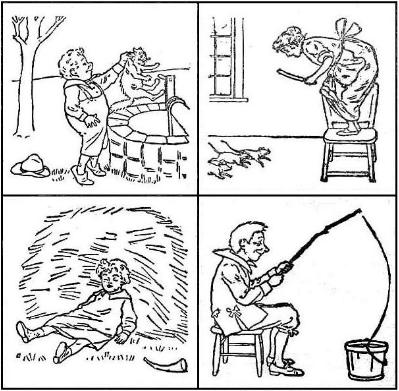
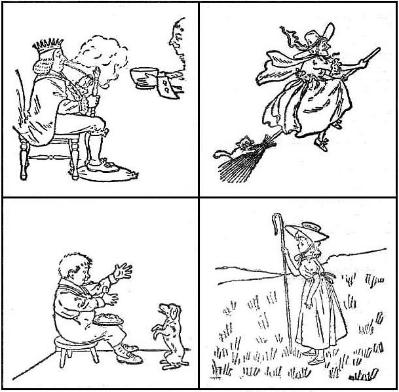
Patricia L. Cummings also questions the term, penny squares, in her online essay, "Penny Squares." Patricia's findings are similar to mine and includes an extensive bibliography on the subject. http://www.quiltersmuse.com/penny-squares.html
~ ~ ~ ~ ~ ~ ~ ~ ~ ~ ~ ~ ~ ~ ~ ~ ~ ~ ~ ~ ~ ~ ~ ~ ~ ~ ~ ~ ~ ~ ~ ~ ~ ~ ~ ~ ~ ~ ~ ~ ~ ~ ~ ~ ~ ~ ~ ~
One day I decided to search NewspaperArchive.com to see what I could find. The only commercial result was the following October 17, 1912, ad from an Oil City, Pennsylvania, department store. It reads:
NEW STAMPED GOODS / Complete assortment Pillow Cases, Pillow Tops, Towels, Stand and Dresser Covers, Laundry Bags and Doylies, and for the children big assortment of the / STAMPED PENNY QUILT BLOCK / teaching them to sew at the same time making something useful and to be prized.
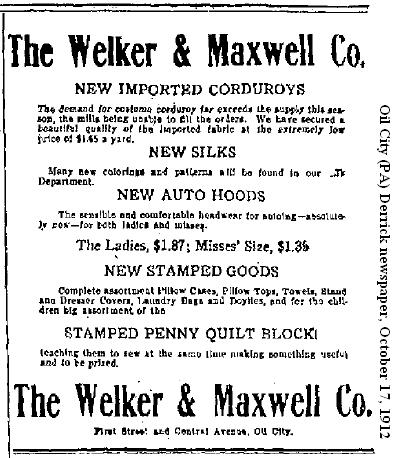
~ ~ ~ ~ ~ ~ ~ ~ ~ ~ ~ ~ ~ ~ ~ ~ ~ ~ ~ ~ ~ ~ ~ ~ ~ ~ ~ ~ ~ ~ ~ ~ ~ ~ ~ ~ ~ ~ ~ ~ ~ ~ ~ ~ ~ ~ ~ ~
This website by Nancy Bekofske shows a quilt of redwork squares said to have been purchased at the 1901 Pan-American Exposition in Buffalo, New York. The squares presumably sold during the exposition for a penny each.
http://theliteratequilter.blogspot.com/2013/06/pan-american-redwork-quilt.html
~ ~ ~ ~ ~ ~ ~ ~ ~ ~ ~ ~ ~ ~ ~ ~ ~ ~ ~ ~ ~ ~ ~ ~ ~ ~ ~ ~ ~ ~ ~ ~ ~ ~ ~ ~ ~ ~ ~ ~ ~ ~ ~ ~ ~ ~ ~ ~
The other search results were much later and revealed three interesting references to penny blocks.
The first of these is in the October 12, 1933, Muscatine (IA) Journal and News-Tribune reporting on a meeting of the I. C. C. Class of Island M. E. Church. The article ended with this brief but intriguing paragraph: "A satisfactory amount was realized from the penny quilt blocks sponsored by the class for the past six months." An attempt to find an earlier article that more fully explains what they did was unsuccessful so we are left to our imaginations for now.
An article two months later may explain the penny blocks in the October article. The same newspaper, December 7, 1933, reported on the Grace Reformed Ladies' Aid meeting: "Plans were made for piecing a crazy quilt as a means of raising money for this month. Anyone piecing a block is asked to put a penny in the treasury for each piece in the block, each one paying not more than 25 cents although as many pieces may be sewn in the block as desired. When completed the quilt top will be presented to the woman whose block contains the most pieces."
The fourth and last result revealed a similar idea. In the February 28, 1938, Evening Huronite in Huron, South Dakota, is a report on a meeting of the M. E. Aid Society: "During the business session the ladies decided to start a penny quilt, each one putting as many pieces on a block as possible and donating one penny for each piece sewed on. After the quilt is completed the one whose block contains the most pieces gets the quilt."
~ ~ ~ ~ ~ ~ ~ ~ ~ ~ ~ ~ ~ ~ ~ ~ ~ ~ ~ ~ ~ ~ ~ ~ ~ ~ ~ ~ ~ ~ ~ ~ ~ ~ ~ ~ ~ ~ ~ ~ ~ ~ ~ ~ ~ ~ ~ ~
I also remembered the term, picture quilt, that I have often seen as I transcribed quilt related text in the old magazines I have accumulated over the past thirty years.
The earliest illustration appeared in Farm and Home (Phelps Publishing, Springfield, MA), April 1, 1892, with this description: "The Picture Quilt. / This is one of the latest innovations on the old-time crazy quilt and is another of those creations which are made up from friendly contributions. The squares are about eight inches across and are made from silk, satin, bolting-cloth over sateen or linen, and decorated with any and every sort of design which may be done in oil, watercolor, outline stitch or pen and ink. The squares are joined neatly together and then the seams are decorated with fancy stitches in various colored silks. When finished line with sateen, challis or any pretty soft material."
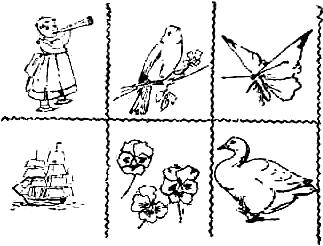
The Hearth and Home (Vickery and Hill, Augusta, ME) needlework editor, writing as one of her readers, included these suggestions in her July 1897 column: "Some one asked how to make a 'mosaic' or picture quilt. This is a description of one I have just completed. It is made of squares, each 6x6 inches, and stamped with a small figure, flowers, fruit, bird, geometrical design, or whatever you like. Outline with red tambour cotton, stitch together, having the squares match evenly, and press the seams open, then featherstitch or cross-stitch the seams. Another way of joining the squares is, fell the edges of each square, then join with loops of crochet work, thus: go around the 1st square with chains of 5 or 7, missing regular spaces, equal to one less than the number of chains. Next square, fasten in, chain 3, catch in center of 7 chain, opposite (on 1st square), chain 3, fasten in 2d square, chain 3, catch in centre of next 7 chain, chain 3, fasten in square, and so on. The finer the cotton used for squares, the prettier the spread. It is pretty 'catch-up' work, and it is pleasant to get new patterns. Could not the squares, with cotton, be offered as a 'special [by the editor]?' Mrs. J. L. H. Westbrook, Me."
In the October 1897 Hearth and Home, a lady offered to exchange a "Beautiful block for picture quilt, 12x12 inches, outlined in natural colors, for ten skeins Ulster etching flax, white, or offers. K. Harkey, New Holland, Pa."
The February 1903 Hearth and Home has another request with a bit of a twist: "I am making a memory quilt and shall be grateful for blocks of bleached muslin, 8x8 inches, worked with name and address of sender, and with some small design, such as is used in crazy-patchwork and picture quilts. Will return favor. Mrs. A. G. Kendall. Box 136, Northport, Wash."
Many similar requests were published over the next two decades, often with illustrations accompanied by instructions for making the blocks and suggestions for finding pictures for them. So it seems that "picture quilts" was the common term as found in periodicals at the time and used by the ladies who made them. The term "penny squares" appears to have a romantic connotation today, and thus its current popularity.
© Wilene Smith, September 8, 2010, all rights reserved (updated May 21, 2016)